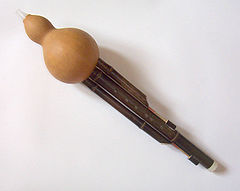- Hulusi
-
-
This article is about the musical instrument. For other uses, see Hulusi (disambiguation).
The hulusi (traditional: 葫蘆絲; simplified: 葫芦丝; pinyin: húlúsī) or cucurbit flute[1] is a free reed wind instrument from China. It is held vertically and has three bamboo pipes which pass through a gourd wind chest; the center pipe has finger holes and the outer two are typically drone pipes. It is not uncommon for a hulusi to have only one drone pipe while the second outer pipe is merely ornamental. The drone pipe has a finger hole, which allows it to be stopped. Advanced configurations have keyed finger holes similar to a clarinet or oboe, which can greatly extend the range of the hulusi to several octaves.
The hulusi was originally used primarily in Yunnan province by the Dai and other non-Han ethnic groups but is now played throughout China, and hulusi are manufactured in such northern cities as Tianjin. Like the related free reed pipe called bawu, the hulusi has a very pure, clarinet-like sound.
Although the hulusi is still predominantly performed in China, it has in recent years been adopted by European composers and performers. Rohan Leach from England, Rapheal De Cock from Belgium and Herman Witkam from the Netherlands have all taken the instrument in new directions.
A similar instrument called hulusheng is a mouth organ with a gourd wind chest.
Contents
Etymology
The instrument's name comes from the Chinese words hulu, meaning "gourd," and si, meaning "silk" (referring to the instrument's smooth tone).[1] The instrument is called bilangdao in the Dai language.[2]
References
- ^ "The Cucurbit Flute". cultural-china.com. http://www.cultural-china.com/chinaWH/html/en/17Traditions978.html. Retrieved 2009-04-22.
External links
- Hulusi page from Pat Missin site
- Hulusi page from ASZA.com site
- Hulusi page from Melody of China site
Video
- Hulusi video from The Musical Instruments E-book
- Axi Dancing Under The Moon performed by the hulusi
Listening
See also
- Bawu
- Traditional Chinese musical instruments
Traditional Chinese musical instruments Silk (string) Plucked Guqin · Se · Guzheng · Konghou · Pipa · Sanxian · Ruan · Liuqin · Yueqin · Qinqin · Duxianqin Bowed Huqin · Erhu · Zhonghu · Gaohu · Banhu · Jinghu · Erxian · Tiqin · Tihu · Yehu · Tuhu · Jiaohu · Sihu · Sanhu · Zhuihu · Zhuiqin · Leiqin · Dihu · (Xiaodihu · Zhongdihu · Dadihu) · Gehu · Diyingehu · Laruan · Matouqin · Yazheng Struck Yangqin · Zhu Bamboo (woodwind) Flutes Dizi · Xiao · Paixiao · Koudi Oboes Guan · Suona Free-reed pipes Bawu · Mangtong Gourd (woodwind) Sheng · Yu · Hulusi · Hulusheng Percussion Wood Muyu · Paiban · Guban Stone Bianqing Metal Bianzhong · Fangxiang · Luo · Yunluo Clay Fou Hide Daigu · Bangu · Paigu · Tanggu Others Xun · Gudi · Lusheng · Kouxian 
This article relating to woodwind instruments is a stub. You can help Wikipedia by expanding it. -

